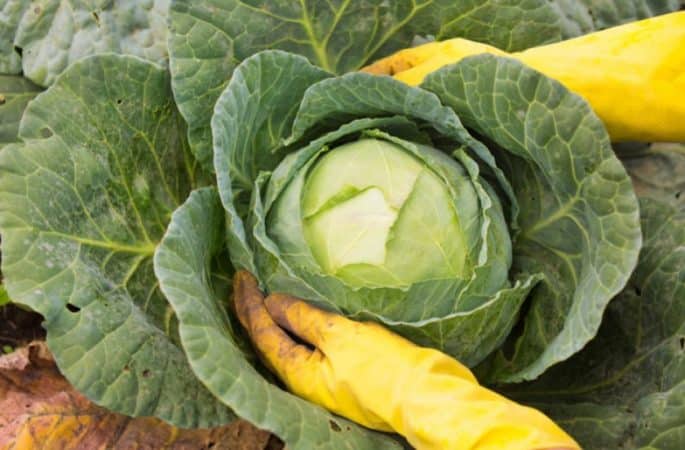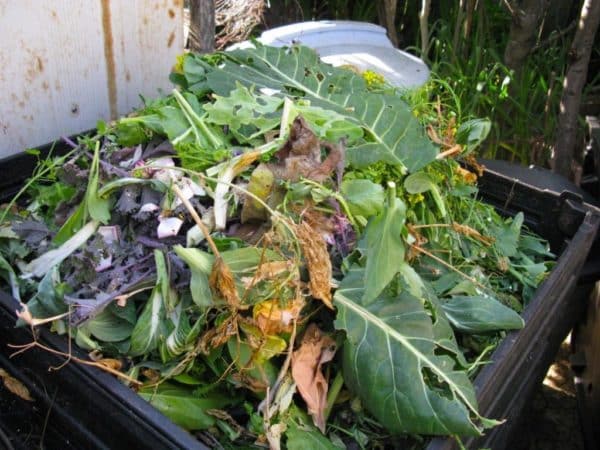Tips on where to put cabbage leaves after harvesting cabbage, and how they can be useful for the garden
The season does not end after harvesting, because the site must be prepared for next year. Properly collected and processed organic residues will become an excellent fertilizer and increase crop yields next year. These also include cabbage leaves, which are present in abundance in the fall in most gardens. You will learn from the article whether it is possible to put them in compost and where to put the roots.
What to do with cabbage leaves after harvesting
There are several conflicting opinions on this matter, which, however, are not without a logical beginning. Cabbage leaves are thrown away, burned or sent to fertilize the soil.

Is it worth throwing them away?
Cabbage leaves quickly will rot in trash heaps. However, organic matter is extremely nutritious for plants, so using cabbage tops as a fertilizer is quite justified. Of course, if the leaves are not affected by late blight and other infections.
Application as fertilizer
This is an environmentally friendly and economical way. Nutrients return to the soil without additional financial investment.
Composition and properties
When studying the chemical composition, it is clear that cabbage tops are a storehouse of useful substances that can significantly improve the quality of the soil and the future harvest:
- Calcium and magnesium, chlorine and phosphorus, sodium, zinc and sulfur, iron and iodine are the main, but not the only useful microelements.
- In addition to the standard set of vitamins for vegetables, cabbage tops are rich in beta-carotene and contain PP, E, H, K, and choline.
- New chemical compounds and microorganisms that have a beneficial effect on plant growth are formed during the fermentation process. That is why it is considered optimal to use compost that contains cabbage leaves.
- Dietary fiber, organic acids and starch accelerate the fermentation process, so compost using cabbage tops matures faster.
What plants is it suitable for?
Top dressing, prepared using cabbage leaves, is suitable for all cultivated plants.
Most often it is used to fertilize cucumbers, peas, beets, carrots, tomato seedlings, peppers and eggplants.
How to properly prepare fertilizer from cabbage leaves
Preparing fertilizer from cabbage leaves does not require any special skill; even a novice gardener can handle this task:
- Cabbage tops are laid between tightly packed weeds, as well as cut leaves of cultivated plants (beets, tomatoes).
- Add black earth and a little hay.
- Fill with water and, tightly closing the container, leave in the sun to ferment.
- The mixture is stirred daily.
- When bubbles and an unpleasant odor appear, indicating the fermentation process, the fertilizer is considered ready for use.
How to apply cabbage leaf fertilizer
The resulting product requires dilution with water in a ratio of 1:4. The mixture is watered on seedlings and young plant shoots.
Using cabbage leaves for compost

Some summer residents avoid putting cabbage leaves in compost because of the persistent unpleasant odor when they rot. However, many are ready to put up with this, because cabbage is a source of a large amount of vitamins and microelements useful for future plants.
For making compost It is better to set aside a separate place, preferably away from fruit trees and so that the sight and smell of rotting grass does not annoy anyone. Compost pits or boxes are often made independently; there are also ready-made plastic options.
It is important to decide on the size in advance and remember some rules for ripening good compost using tops.
Where to put cabbage leaves after harvesting cabbage:
- Waste is placed in a compost pit along with stems, branches, roots of other plants, fallen leaves and half-rotten fruits of trees.
- The leaves are laid in layers between other plant waste, which will compensate for the juiciness of the tops.
- The top of the compost pit is watered with copper sulfate and covered with fallen leaves. The fertilizer remains in this form until next year.
- Tough stems and roots do not always have time to rot over the winter. If they get into the hole, you will have to leave the compost for another year.
Is it possible to add cabbage with caterpillars to compost?
Caterpillars can cause significant damage to most cultivated plants. It is difficult to detect and destroy them in the ground. For this purpose, it is recommended to water the soil around the plants with a lime solution.
The caterpillars themselves are not dangerous for compost, because during the winter they pupate and turn into butterflies. They lay larvae, from which caterpillars will appear again next year, destroying your crop.
Attention! If you do not want to contribute to their proliferation, use only clean tops for compost. It is better to burn all contaminated waste.
Is it possible to bury them in the garden?
Many owners of summer cottages prefer not to waste time creating compost, but simply bury cabbage leaves in the beds. However, experienced agronomists do not recommend resorting to this method.
Buried leaves will become a good bait for field mice, which, after destroying the cabbage, will begin to attack the bulbs of perennial plants. Pre-fertilized beds are more likely to harbor slugs, and fighting them is not an easy task.
Where to put the roots and stalks
Roots and stalks are checked for signs of diseases and pests. If any are found, it is recommended to burn the waste. Healthy stalks and roots are quite suitable for compost.
The only negative is that due to their size and density, they most often do not have time to rot over the winter. The compost will have to be left to mature for another year.
Reference. If you chop the stalks before putting them into compost, this will somewhat speed up its ripening. Sometimes they are buried separately.
Conclusion
Cabbage leaves as an organic fertilizer are absolutely harmless. Such a gift of nature should not be neglected. Preparing the mixture does not require much effort on the part of the gardener. Natural and nutritious fertilizing will help you get an even better harvest without additional investments and the use of chemicals.